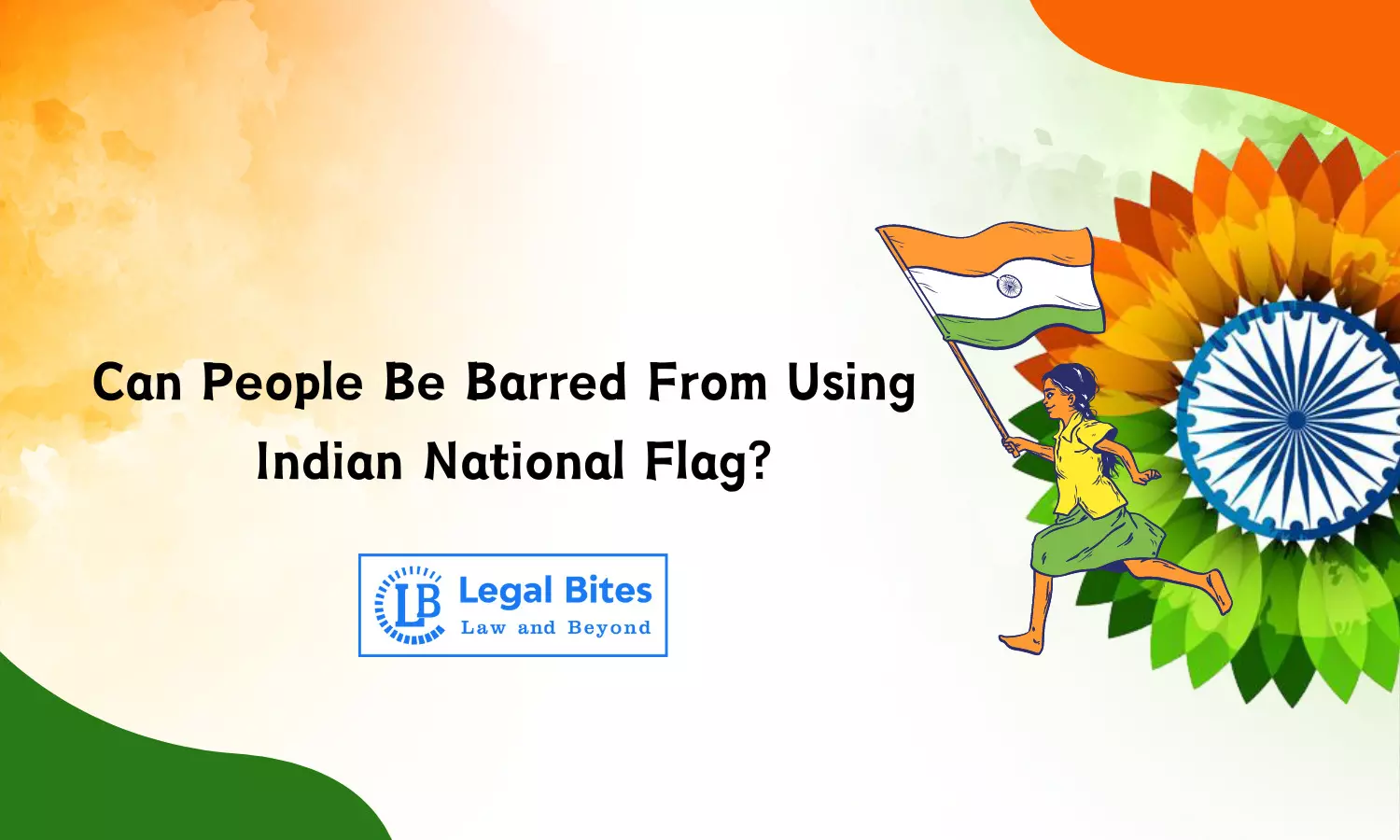Can People Be Barred From Using Indian National Flag?
The article provides a comprehensive overview of the legal guidelines for using the Indian National Flag.

This article thoroughly examines the legal framework governing the display of the national flag and outlines the preventative measures specified in the laws for any violations.
Introduction
The Indian National Flag consists of tricolours, i.e., saffron, white, and green, along with Ashoka Chakra in the middle of the white. The flag stands as a symbol of India’s sovereignty, unity, and rich heritage. It also contains the identities of various struggles that occurred over the period. Yes, the national flag stands and represents India, even for its citizens. Will it be fair if we restrict such citizens from either flying or hoisting the national flag? Even though the Constitution of India explicitly states that every person has the right to fly the national flag, there is still debate about who can use it, when it can be used, how it can be used etc. This raises the question of whether people can be barred from using the Indian National Flag. To prevent such further questions, certain guidelines have been stated through acts.
History of Adopting India’s Flag
The first national flag of India was adopted in 1906, and comprised three horizontal stripes of colour i.e., red, yellow, and green, and was ready to be hoisted on August 7, 1906, at Parsee Bagan Square, near Lower Circular Road, in Calcutta.
Later in 1921, a basic design for the national flag was suggested by freedom fighter Pingali Vekayya to Mahatma Gandhi, that comprised only two colours i.e., red and green bands.
In 1931, a new tricolour for the national flag was accepted after several ongoing changes at a Congress Committee meeting in Karachi.
On July 22, 1947, the newly adopted flag was presented before everyone in the Constituent Assembly. The National flag of India features a horizontal tricolour with deep saffron (Kesari) at the top, white in the middle, and dark green at the bottom, all in equal proportions. The flag's width-to-length ratio is 2:3. At the centre of the white band, there is a navy blue wheel known as the chakra. This wheel is designed after the one on the abacus of the Sarnath Lion Capital of Ashoka. The diameter of the chakra is nearly the same as the width of the white band and it consists of 24 spokes.
What is the Flag Code of India, 2002?
This code not only governs the display of the national flag in private, public and government institutions but also brings together all the laws and instructions for the display of the national flag.
Rules and regulations
This code allowed every citizen to display the national flag if the dignity and honour of it were respected.
Rules for displaying the National Flag
- While placing the Indian national flag, it shall occupy the position of honour and display instinctively.
- Where the Flag is displayed in the open or displayed on the house of a member of the public, it may be flown day and night (amended vide Order dated July 20, 2022).
- The flag shall be hoisted immediately and lowered slowly and ceremoniously.
- The saffron band shall be at the top when the flag is displayed horizontally and flat on a wall.
- The saffron band shall be on the right when displayed vertically.
- The flag shall be displayed on the right side of the speaker or flat against the wall that is behind or above the speaker.
- While unveiling the statue, the flag will be displayed distinctively.
- During the march, the flag shall be on the right or at the front of the centre line when a line of other flags exists.
Guidelines for the Respectful Display and Handling of the National Flag
- It shall not be displayed in the reverse position.
- A damaged National Flag shall not be displayed.
- It shall not be dipped in salute to any person or anything.
- Neither any flag shall be placed higher than the national flag nor any object.
- It shall not be used for decoration.
- It shall not be allowed to touch the ground or water.
- It shall not be used to cover or drape the speaker’s desk.
- It shall not be displayed in the form of a uniform or accessory.
According to Article 51(A) of the Constitution of India, citizens must respect and adhere to the National Flag of the country.
Situations where the Flag can be displayed
At home/open-
Any individual, educational institution, private and public organization can display the national flag on any day as per the Flag Code of India, 2002. The dignity and honour of the flag shall be protected properly.
At half-mast-
It shall be displayed according to government-issued instructions.
On vehicle-
This privilege is provided to only:
- President
- Vice-President
- Governors and Lieutenant Governors
- Heads of Indian Missions/Posts
- Prime Minister
- Cabinet Ministers
- Minister of State
- Deputy Ministers of the Union
- Chief Minister and Cabinet Minister of a State or Union Territory
- Speaker of the Lok Sabha
- Deputy Chairman of Rajya Sabha
- Deputy Speaker of Lok Sabha
- Chairman of Legislative Councils in States
- Speakers of the Legislative Assemblies in States and Union Territories
- Deputy Chairman of Legislative Council in States
- Deputy Speakers of Legislative Assemblies in States and Union Territories
- Chief Justice of India
- Judges of the Supreme Court
- Chief Justice of High Courts
- Judges of High Courts
Display with other Countries' Flag
As per the Flag Code of India, 2002, the Indian flag shall be displayed at the extreme right while following the flag of other countries in alphabetical order.
If the flag is flown in a circle formation, then the national flag shall be flown first, following the other countries in a clockwise direction.
Restrictions that Prevent the Misuse of National Flag
According to the Prevention of Insults to National Honour (Amendment) Act, 2003, it describes the word ‘disrespect’ towards the National Flag.
Section 2 of the Act says that whoever in a public place or any other place burns, defaces, defiles, mutilates, disfigures, destroys, and tramples upon or brings into contempt by any comment towards the national flag shall be punished with imprisonment for three years or fine or both.
According to the State Emblem of India (Prohibition of Improper Use) Act, 2005, it keeps a check on the usage of the national flag and penalizes if it is done for personal usage through any means.
Importance of treating the flag with dignity
Legal Compliance: Acts and codes provide rules and regulations for how the national flag shall be treated. Also, to prevent disrespectful behaviour towards the national flag.
Promotion of Patriotism: Legal provisions related to flag etiquette promote a culture of patriotism. They help to create a sense of pride and responsibility to honour the national flag.
Uniform Standards: It helps in creating standards about whether a flag shall be displayed, handled, and disposed of. It creates and ensures the same level of consistency in every aspect of the flag displayed, handled, and disposed of that continues while spreading the same knowledge.
Protection of the National Flag: Legal consequences are stated for the protection if anyone misuses it and shows disrespect.
Case Laws
In Union of India v. Naveen Jindal, (2004), the petitioner Naveen Jindal filed a petition before the High Court, and he was prevented from flying the national flag over his building premises.
The court held that flying the national flag falls under Article 19(2) of the Constitution of India and it is a symbol of free spirit towards the country. Preventing them from flying will violate their rights. Also, allowing officials and high dignitaries to fly the national flag and restricting common people shall violate Article 14 of the Constitution of India.
A new petition was filed by the Union of India in the Supreme Court for the same query, that every country has its own set of rules and regulations for the protection of the national flag that shall not violated by the citizens, but that doesn’t mean that people shall be restricted from flying the national flag only out of fear disrespecting it.
In V.K. Naswa v. Union of India,(2016), the court held that there is no such requirement for hoisting the national flag on public buildings on all days.
In Amgonda Vithoba Bandhare v. Union of India, (2011) the court held that if the flag is not lowered after sunset, it shall not be stated as an offence under Explanation 4 or in Section 2 of the Prevention of Insults to National Honour Act. Even at the outset, it doesn’t constitute an offence under Section 2 of the act.
Conclusion
People aren’t barred from using the Indian National Flag but it prevents disrespect towards it. People can fly or hoist the national flag with pride, but it must be done responsibly, encouraging its use. Legal measures have been stated to prevent the disrespectful use. This approach ensures a symbol of unity and inspires everyone.
References
[1] FAQs, Indian National Flag, Available Here
[2] Flag Code of India (2002), Available Here
[3] India’s Flag Code Rules, Available Here
[4] Union of India v. Naveen Jindal & Anr, 2004 (2) SCC 510
[5] V.K. Naswa v. Union of India, Writ Petition:13829-2016
[6] Amgonda Vithoba Bandhare v. Union of India, Writ Petition No. 3459 of 2011

